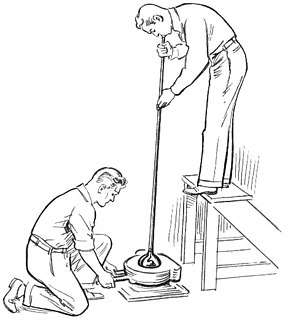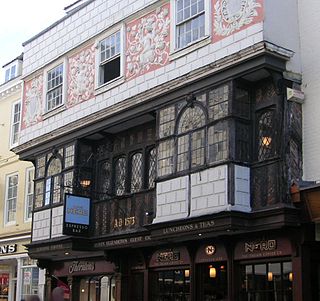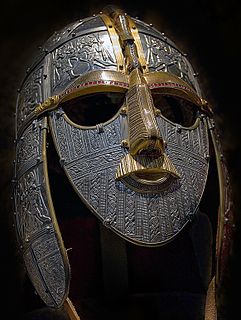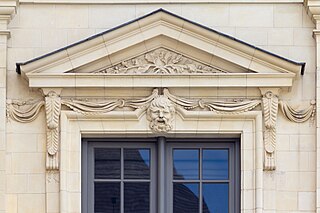
The term stained glass can refer to coloured glass as a material or to works created from it. Throughout its thousand-year history, the term has been applied almost exclusively to the windows of churches and other significant religious buildings. Although traditionally made in flat panels and used as windows, the creations of modern stained glass artists also include three-dimensional structures and sculpture. Modern vernacular usage has often extended the term "stained glass" to include domestic lead light and objects d'art created from foil glasswork exemplified in the famous lamps of Louis Comfort Tiffany.

Glassblowing is a glassforming technique that involves inflating molten glass into a bubble with the aid of a blowpipe. A person who blows glass is called a glassblower, glassmith, or gaffer. A lampworker manipulates glass with the use of a torch on a smaller scale, such as in producing precision laboratory glassware out of borosilicate glass.

Float glass is a sheet of glass made by floating molten glass on a bed of molten metal, typically tin, although lead and other various low-melting-point alloys were used in the past. This method gives the sheet uniform thickness and very flat surfaces.

Cathedral glass is the name given commercially to monochromatic sheet glass. It is thin by comparison with slab glass, may be coloured, and is textured on one side.
Glass tubes are mainly cylindrical hollow-wares. Their special shape combined with the huge variety of glass types, allows the use of glass tubing in many applications. For example, laboratory glassware, lighting applications, solar thermal systems and pharmaceutical packaging to name the largest.

The technology for glass beadmaking is among the oldest human arts, dating back 3,000 years. Glass beads have been dated back to at least Roman times. Perhaps the earliest glass-like beads were Egyptian faience beads, a form of clay bead with a self-forming vitreous coating. Glass beads are significant in archaeology because the presence of glass beads often indicate that there was trade and that the beadmaking technology was being spread. In addition, the composition of the glass beads could be analyzed and help archaeologists understand the sources of the beads.

Broad sheet is a type of hand-blown glass. It was first made in Sussex in 1226.
Polished plate is a type of hand-made glass. It is produced by casting glass onto a table and then subsequently grinding and polishing the glass. This was originally done by hand, and then later by machine. It was an expensive process requiring a large capital investment.
Cylinder blown sheet is a type of hand-blown window glass. It is created with a similar process to broad sheet, but larger cylinders are produced by swinging the cylinder in a trench. The glass is then allowed to cool before the cylinder is cut. The glass is then re-heated and flattened. The result is much larger panes and improved surface quality over broad sheet.
Machine drawn cylinder sheet was the first mechanical method for "drawing" window glass. Cylinders of glass 40 feet (12 m) high are drawn vertically from a circular tank. The glass is then annealed and cut into 7 to 10 foot cylinders. These are cut lengthways, reheated, and flattened.

Crown glass was an early type of window glass. In this process, glass was blown into a "crown" or hollow globe. This was then transferred from the blowpipe to a punty and then flattened by reheating and spinning out the bowl-shaped piece of glass (bullion) into a flat disk by centrifugal force, up to 5 or 6 feet in diameter. The glass was then cut to the size required.

Architectural glass is glass that is used as a building material. It is most typically used as transparent glazing material in the building envelope, including windows in the external walls. Glass is also used for internal partitions and as an architectural feature. When used in buildings, glass is often of a safety type, which include reinforced, toughened and laminated glasses.

Chance Brothers and Company was a glassworks originally based in Spon Lane, Smethwick, West Midlands, in England. It was a leading glass manufacturer and a pioneer of British glassmaking technology.

Anglo-Saxon glass has been found across England during archaeological excavations of both settlement and cemetery sites. Glass in the Anglo-Saxon period was used in the manufacture of a range of objects including vessels, beads, windows and was even used in jewellery. In the 5th century AD with the Roman departure from Britain, there were also considerable changes in the usage of glass. Excavation of Romano-British sites have revealed plentiful amounts of glass but, in contrast, the amount recovered from 5th century and later Anglo-Saxon sites is minuscule.

Plate glass, flat glass or sheet glass is a type of glass, initially produced in plane form, commonly used for windows, glass doors, transparent walls, and windscreens. For modern architectural and automotive applications, the flat glass is sometimes bent after production of the plane sheet. Flat glass stands in contrast to container glass and glass fibre.

Medieval stained glass is the coloured and painted glass of medieval Europe from the 10th century to the 16th century. For much of this period stained glass windows were the major pictorial art form, particularly in northern France, Germany and England, where windows tended to be larger than in southern Europe.

The history of glass-making dates back to at least 3600 years ago in Mesopotamia. However, some claim they may have been producing copies of glass objects from Egypt. Other archaeological evidence suggests that the first true glass was made in coastal north Syria, Mesopotamia or Egypt. The earliest known glass objects, of the mid second millennium BC, were beads, perhaps initially created as the accidental by-products of metal-working (slags) or during the production of faience, a pre-glass vitreous material made by a process similar to glazing. Glass products remained a luxury until the disasters that overtook the late Bronze Age civilizations seemingly brought glass-making to a halt.

Glass art refers to individual works of art that are substantially or wholly made of glass. It ranges in size from monumental works and installation pieces, to wall hangings and windows, to works of art made in studios and factories, including glass jewelry and tableware.
Early American molded glass refers to functional and decorative objects, such as bottles and dishware, that were manufactured in the United States in the 19th century. The objects were produced by blowing molten glass into a mold, thereby causing the glass to assume the shape and pattern design of the mold. Common blown molded tableware items bearing designs include salt dishes, sugar bowls, creamers, celery stands, decanters, and drinking glasses. Household items, other than dishware, made using the three-mold method include inkwells, oil lamps, birdcage fountains, hats, medicine and perfume bottles, and witch balls. Whiskey flasks bearing unique designs were made in two part molds. Undecorated bottles used as containers for a variety of liquids were blown into square molds to give them corners so they could be packed into compartments of wooden cases.
Vauxhall glassworks was a plate glass factory off what is now the Albert Embankment in the Vauxhall area of Lambeth, London, just to the north of Vauxhall Gardens. The site is now commemorated in the name of Glasshouse Walk.


















